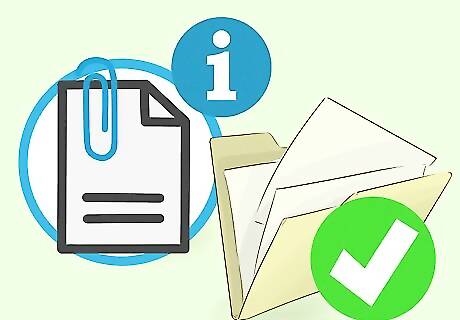
views
X
Research source
[2]
X
Trustworthy Source
U.S. Small Business Administration
U.S. government agency focused on supporting small businesses
Go to source
Choosing Your Name

Decide whether you need a DBA. Typically a DBA is needed if you are a sole proprietor running a business under a different name than your own. If you run a sole proprietorship, your own name is the registered name of and for the business. However, most business owners choose a different name for their business. Even if you've simply added a word or two to your own name, this is still considered a DBA. For example, if Sally Spade runs a candy shop called Sally Spade's Sweets, this would be considered a DBA even though Sally's name is included. You also might need a DBA if you have a corporation, LLC, or other registered business entity, but the entity includes other stores or businesses under its umbrella that use a different name. For example, if Sally Spade has incorporated her candy business as Sally Spade's Sweets, Inc., she would need a DBA if that corporation operated a store called Sweets-R-Us. A DBA also can be handy if you plan to market to different demographics or age groups. Creating a new name allows you to tailor your advertising and marketing materials to reach different types of people, even though you may be selling virtually the same products or services.

Brainstorm possible names. You should choose a business name that is unique and easy to remember, spell, and pronounce. Keep in mind that you want potential customers to associate your business name with whatever products or services you provide, so the name you choose ideally should be related to what your business does. For example, Sally Spade has chosen "Sally Spade's Sweets," a catchy, alliterative name that brings to mind candy and other sweet treats, for her candy shop. It's doubtful people would be confused about what sort of store she operates. However, if she named her business "Sally Spade's Shovels" instead, people probably would be rather shocked when they walked into her shop expecting garden tools and instead faced candy bins and platters of fudge. Avoid names that potentially limit your business. Using a geographical designation, for example, might cause problems if you decide later on to open a second store in another town or region. The same is true for products and services. Sally Spade's Sweets could include not just candy, but any type of sweet food. However, if Sally had chosen the name "Sally Spade's Jawbreakers," she would have potentially limited her business to a single type of candy. You also might consider talking to potential customers to get their feedback on your name ideas. You don't have to spend a lot of money on marketing services – simply ask friends or people you know. You could even use your social media accounts to get ideas and feedback about the different names you're thinking about using.

Research the names on your list. You must check with your state's Secretary of State and other records to make sure the name isn't already being used. Avoid using a famous name or brand, even if you're selling something entirely different. Major companies have federal trademarks, and you could get sued for using their name and attempting to profit from their reputation. In every state, business entities such as corporations or LLCs must register with the Secretary of State. The Secretary of State's office will have a registered names database that you can check to make sure the name you've chosen isn't already in use. Not only can taking a name that someone else is already using put you at risk for a lawsuit, but you may have difficulty registering the name, or applying for trademark protection, later on. If you plan on having a website for your business, you also should check the availability of a domain name that matches your proposed DBA. As with the DBA itself, your domain should be easy to spell and remember. If your DBA is already taken, you may think you can remedy the problem by adding hyphens, underscores, or numbers. However, keep in mind that people may have a hard time remembering to add those extra characters, and if another website is out there that's similar, you run the risk that people will look for your website and end up on the other company's page. In addition to checking the state or county databases of registered names, you also should run a quick search on the internet to make sure the name isn't being used by someone else. Even if they haven't registered the name or aren't located in your area, customers might confuse the two businesses if they have similar names.
Registering Your Name

Find out your state's registration requirements. Many states have specific requirements for registering an assumed or fictitious business name. Not all states require you to register a DBA. However, even in states that don't require DBA registration, individual counties within the state may require DBA registration. Some states require you to file registration documents with both state and county agencies. You must check registration requirements for all the states and counties where you plan to do business. For example, if Sally Spade lives in Nashville, Tennessee, and plans to open candy shops in downtown Nashville and in nearby Franklin, she potentially would need to register her DBA in both Davidson and Williamson counties.

Locate and complete the required forms. If your state requires you to register your DBA, you typically can find the forms you need at your county clerk's office. Some states or counties may have the form available online, which you can download and fill out. If you can't find information online, your best option is to call your county clerk's office and ask for information about the procedures and requirements.

File your DBA forms. Once you've completed your form, you must file it with the appropriate state or county agency and pay the required fees. In most states, you only have to register your name at the county level. However, some states require you to register with the secretary of state, just as you would if you were a corporation or LLC. When you file your forms, you'll have to pay a filing fee, usually between $10 and $50.

Publish notice, if required. Some counties require you to publish notice of your new DBA in a newspaper for a period of time. If publication is required, the county typically will have deadlines you must meet. For example, if you file a DBA in Chicago, Cook County requires your first publication to be no later than 15 days after the date on your application. Publishing a legal notice in your local newspaper usually is sufficient to meet this requirement. The county clerk's office also may have a list of newspapers that are approved by the state or county to meet the notice requirement. The county also will provide specific requirements regarding the rate of publication, and how long the notice must run. For example, Cook County requires your notice to run once a week for three consecutive weeks. After you've published your notice, you typically must file an affidavit or other proof of publication with the state or county agency.

Get an Employer Identification Number from the IRS. You will need an EIN to file taxes and for other government forms and documents. Although as a sole proprietor you can simply use your own Social Security number, it is recommended that you get an EIN to keep your business records and dealings separate from your own personal information. You can apply for an EIN from the IRS at no charge by visiting https://www.irs.gov/businesses/small-businesses-self-employed/apply-for-an-employer-identification-number-ein-online. You will need to use your EIN along with your DBA on all government forms and applications, including those for licenses or permits.

Receive your DBA certificate. After you've completed the necessary registration requirements, the state or county agency will mail your DBA certificate. Keep in mind that in can take as long as four weeks to receive your certificate after you've filed your application – perhaps longer if you must publish notice and file proof of publication. Make sure you've filed early enough that your DBA registration will be in place before you open your business to the public. Make copies of your certificate and keep the original in a safe place. You may need to show the original or provide a copy to complete certain business transactions, apply for licenses, or open a bank account in the business's name.

Comply with other state or county filing requirements. Depending on how you've structured your business or what kind of goods or services your business provides, your state may have additional licensing or registration requirements. For any license applications, you'll typically be required to use the full legal name of the business. For example, when Sally Spade applies for her health permit, she would use "Sally Spade d/b/a Sally Spade's Sweets." Your state or county may require you to update your DBA registration to maintain it after a certain amount of time. For example, if you file a DBA in Austin, Texas, the registration is good for 10 years, at which point you would need to renew your registration.
Applying for Trademark Protection

Decide whether you need federal trademark protection. While you can register for a trademark in any state, applying for a federal trademark with the United States Patent and Trademark Office will protect your name nationwide provided your DBA qualifies. A trademark protects your unique business name by giving you the right to sue anyone else who uses it in commerce. However, just because your name is unique doesn't necessarily mean it can be trademarked – at either the state or the federal level. Generally, you must use (or intend to use) your DBA in interstate commerce to qualify for a federal trademark. If, for example, you planned to sell products through your website to customers nationwide, that would qualify as interstate commerce. If you're not planning on using your DBA outside your local area, you still may be eligible for state trademark protection. Rather than giving you exclusive rights to use your DBA nationwide, you only have those rights within a specific geographic area.

Research your name. Before you apply for trademark protection, check the state or federal databases to make sure no one else is claiming trademark rights for a similar name. The USPTO provides an electronic search system you can access online at http://www.uspto.gov/trademarks-application-process/search-trademark-database. The database provides information on registered trademarks as well as pending applications and abandoned marks. Each state also has its own trademark database, typically located on the secretary of state's website. If you're planning on doing business in more than one state, you would need to check the databases for each of those states to make sure your name is available. You also might consider using a screening service available on sites such as trademark.com, which will search federal and state databases for a fee. Keep in mind that just because another business is using the same name as yours doesn't mean that you can't use it. If the other business is located far away, or is offering different products or services, you still may be able to use the name. Just because you can use a name that's similar to someone else's, however, doesn't mean you necessarily should. This is especially true if you plan on selling products on your website to people nationwide. For example, when Sally Spade was researching her DBA, she discovered that there was an exotic dancing club in Nevada called Sally Spade's Sweeties. While the two businesses are vastly different, and Sally has no plans on opening an exotic dance club, she might be concerned that candy customers searching online for her website could end up on the exotic dancing club's page.

Consider hiring an attorney. Trademark applications, especially federal applications, can be complicated. An experienced trademark attorney can help ensure your information is correct and your application is approved. An experienced trademark attorney also has familiarity with the USPTO and the application examination process. If you find any of the application materials confusing, an attorney can make sure you don't end up having to file multiple applications as a result of a denial.

Fill out your trademark application. Your application must include information about the name you want to trademark, as well as where and how you intend to use it. Initially, you must decide what format you'll use for your trademark, and the goods and services to which your trademark will apply. You also must decide whether you want to file your application on the basis of commercial use, or intent to use. If you haven't used your DBA yet and file on the basis of "intent to use," you will have to fill out additional forms and pay an extra fee.

File your trademark application. Once you've completed your application, file it with the appropriate agency and pay the required fees. You can file your application with the USPTO electronically using the USPTO's website. Once you file, your pending application becomes a matter of public record and will show up on the USPTO database if anyone else searches for a similar name. Federal trademark processing fees are a minimum of $375, and may be more if you are applying to register your trademark in multiple commercial classes. No part of this fee is refundable, regardless of whether your application is denied. State registration typically only involves a minimal fee, and involves a less complex application process.

Work with the application examiners. If you applied for federal trademark protection, your application will go through an examination process and be evaluated by USPTO trademark attorneys. Provided you meet the minimum requirements, your application will be assigned a serial number and referred to an examining attorney for review. The attorney may issue a letter requiring additional information or revisions to your application before it can be reviewed. If you receive such a letter, you must respond within six months or the USPTO will consider your application abandoned and you will have to start the process over again.

Monitor the status of your application. Since it can take several months to process a trademark application, you should check regularly so you don't miss any deadlines. If your address or other contact information changes during the application process, make sure you update the application records so they remain correct. Once the examining attorney determines your application should be approved, the USPTO will publish notice of the mark in its official gazette. Anyone who believes they would be damaged by registration of your mark has 30 days to file an opposition to registration document with the USPTO. If no opposition is filed, your registration certificate will be issued. If opposition is filed, a hearing will be held before the Trademark Trial and Appeal Board.

Maintain your trademark. After your application is approved, you must file documents periodically and pay fees to keep your registration active. If you don't complete the maintenance requirements by the required deadlines, your mark will expire or be cancelled. If this happens, you must file a new application and go through the entire process again to regain trademark protection.



















Comments
0 comment